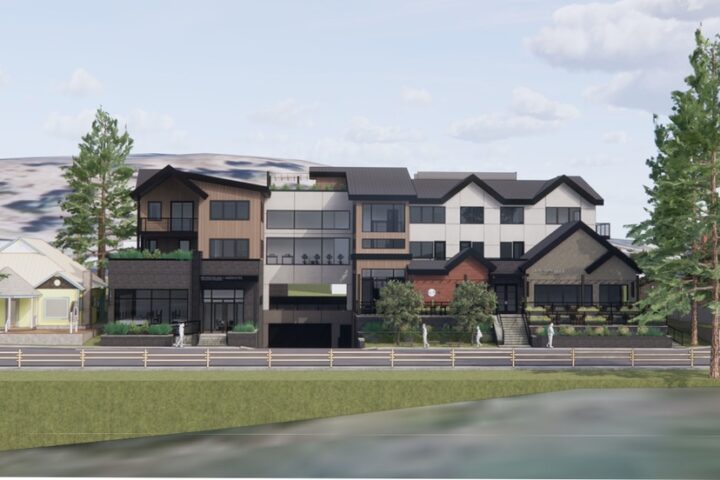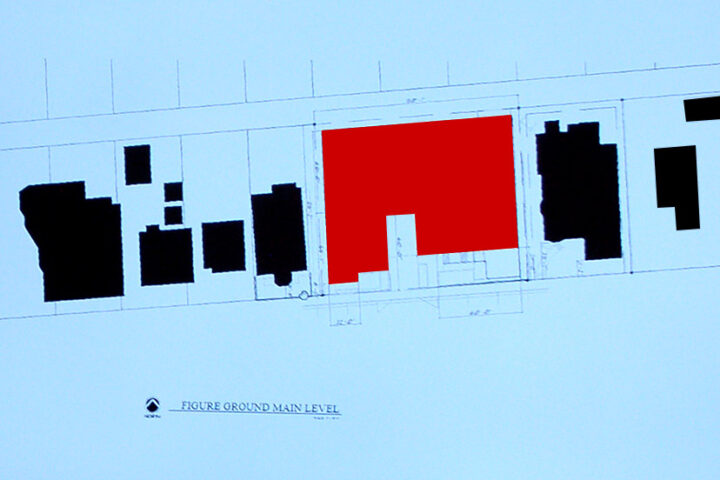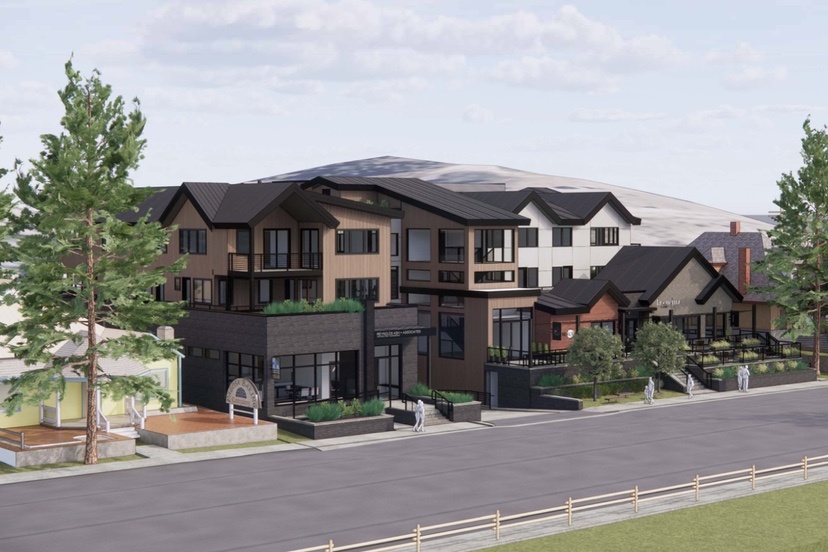On January 23, the Town of Pagosa Springs Planning Commission, which also sits as the municipal Design Review Board, approved the final design for the ‘Eagle Mountain’ mixed use development — a three-story building at 232 Pagosa St. (Highway 160) located between the Alley House Grille and the Pagosa Baking Company.
The vote — which specified certain conditions still needing to be met — was three in favor, one opposed.
As approved by the Design Review Board, the building would include three stories of residential, office, and restaurant space over a single level underground parking garage, to include seven condominiums, 3,000 SF of commercial space, 2,100 SF of restaurant, and 10,000 SF of underground garage, plus landscaped patios and outdoor dining and gathering spaces.
The final design includes some changes since the board originally approved the project’s ‘sketch plan’ in September, 2022, with some of the changes apparently aimed at addressing previous criticisms expressed by the Board and by the surrounding neighbors. The developers had been asked to address those criticisms when the ‘sketch plan’ was approved in 2022.
Changes included a reduced number of residential units (reduced from eight to seven) and mainly cosmetic changes to the overall building mass. The Town Planning Department staff were apparently not completely satisfied with the design on the sides and rear of the building.
Concerned neighbors and town residents who packed the meeting audience also expressed opposition to the final design.

Some of those same neighbors and property owners had objected to the sketch design when it was approved by the Design Review Board in September 2022, and had appealed that decision to the Pagosa Springs Town Council two months later, based on the language included in the Town’s Land Use and Development Code (LUDC).
At the December 2022 appeals hearing, which we discussed here in the Daily Post, the Town Council listened carefully to objections from surrounding property owners, such as Pagosa Baking Company co-owner Kirsten Sheehan:
“One of the things I wanted to talk about was ‘voluntarily making things smaller.’ We’ve been hearing about the [nearby] Town Terrace, a lot. And I don’t know if you recall, when that application first went out, they were asking for a variance on the [number of required] parking spots, because the design was bigger than it finally ended up being, and they didn’t have enough room for the required parking.
“So we went to [developer] Susan Winter Ward and said, ‘Why don’t you just make it smaller?’ And she did. So instead of looking for a variance, she just plain made it smaller, which we really appreciated…”
“[A reduction in size] can be done voluntarily. It doesn’t have to be, ‘Alright, I’ve got this piece of land; I’m going to build it as big as I can, because that’s the way to go…'”
“Supreme Court Justice Potter Stewart famously said, in his 1964 order, that he could not use words to describe pornography, ‘but I know it when I see it.’ And that’s how I feel about the mass of this project. That’s what the Downtown Master Plan was trying to clarify when using terms like, ‘mass and scale that reflects existing residential building size’… ‘respecting the scale of adjacent buildings’… ‘traditional setbacks’… ‘smaller scale buildings’… ‘open space and yards between’… ‘limiting lot consolidations in order to create natural breaks in building facade widths that emulate historical development patterns.’
“[Architect] Brad Ash gave a good discussion about how much experience he has interpreting the LUDC. And he comes to that interpretation from the point of view of an architect. His job is to fit as much building for the buck as he can on the given space, so he’s going to interpret it that way…”
“interpretation” is part of government decision-making. It can be done objectively, or subjectively. Speaking as a citizen who has felt compelled to challenge certain local government actions in District Court, I can agree that many of the serious disagreements sparked by government decisions — and business decisions, and human decisions, in general — come from different interpretations of the very same words.
Take ‘smaller scale buildings’, as one example. Three words, written in a certain pattern, and open to interpretation. If you compare the three-story structure proposed for 232 Pagosa Street with the neighboring buildings, it is definitely not ‘smaller scale.’ Here’s a view of the proposed building footprint, compared to its existing neighbors, based on a drawing shared by the architects last Thursday:

If you decided to compare 232 Pagosa Street to, say, the 98,000 square-foot Walmart store uptown, you could argue that the proposed structure is a ‘smaller scale building’.
That argument works, if you isolate the phrase from its meaningful context — the context being, the surrounding neighborhood. As soon as you put ‘smaller scale buildings’ within the same paragraph as ‘respecting the scale of adjacent buildings’… your comparison to Walmart becomes disingenuous.
I don’t see how anyone who has bothered to read the Town’s 135-page Downtown Master Plan, with the goal of honestly understanding its original intent, could approve the 232 Pagosa Street proposal.
But a person who wishes to sidestep the Master Plan’s original intent — say, a developer seeking to build the largest possible building on three vacant lots, with the maximum square footage allowed by certain ‘general’ land use regulations, and the maximum height allowed by other ‘general’ land use regulations — such a person can quote pieces of the LUDC and the Downtown Master Plan… out of context… and make it sound like he (or she) is doing exactly what those documents allow, and nothing more.
It’s called ‘interpretation’ and you can make a lot of money doing it.
Back in 2022, when the neighbors appealed the 232 Pagosa project approval to the Town Council, the Council rejected the appeal, in part because the ‘sketch approval’ was ‘not a final decision’. Certain Council members expressed the opinion that the project would be coming back for final approval — and, if given that final approval, the neighbors could then file an appropriate appeal of the decision.
It appears that time may have arrived. For another appeal?

